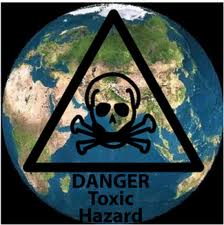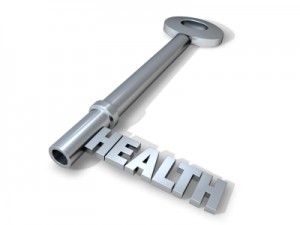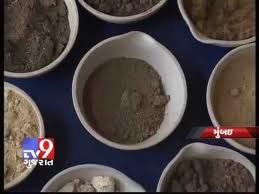The following article is about living in a toxic world. In the past nobody worried about toxicities except parents when their children were gnawing on lead paint. Paint always contained lead and people thought that it was only children we had to worry about. We thought that adults were “immune” to this. We learnt a lot about lead toxicity from early studies in Germany and it was there that EDTA was developed in 1935 to treat children with lead toxicity. During the Second World War when ships were painted with lead containing paints many soldiers were poisoned with lead. EDTA treatment protocols that had been developed earlier for children were found to be also effective for these soldiers.
Lead poisoning from Chinese made toys and mercury poisoning from the air
Fast forward to 2013. We all have heard of lead poisoning from Chinese made toys, from Chinese fashion jewelry and we have heard of the melamine poisoning of baby food and candies. These are not the only poisonings. Mercury is in the air; it is also present in light bulbs and in cruise ship exhaust fumes from incineration of light bulbs and batteries. We have over 600 chemicals and carcinogens in cigarette smoke, which is perhaps the largest “legal” roulette game involving humans where several poisons are inhaled at once. Our water is chlorinated or fluoridated, which interferes with our thyroid gland function. Vegetables that are supposed to be healthy for us contain residues from insecticides and herbicides that have estrogen-like activities called xenoestrogens.
Xenoestrogens can cause breast cancer
They are known to cause breast cancer in women and prostate cancer in men. Milk in the US often contains antibiotics and genetically modified bovine growth hormone (rBGH), which again can cause various cancers in humans as this link shows. rBGH is banned in Europe and in Canada. The problems do not stop at chemicals in our water, environment, food and air, the newest threat is genetically modified food like wheat, corn and high fructose corn syrup, which is manufactured from GMO corn. Other GMO foods are golden rice, sugar beet, yellow crookneck squash, cotton for cottonseed oil, soybeans, canola, Hawaiian papaya, just to name a few. GM food is illegal in most European countries, but the US is trying very hard to push for “fair trade practices” in order to expand the market for GM foods.
GMO and endometriosis
How does all of this affect your body? One of the publications from France found that genetically modified food is likely responsible for the increase of endometriosis in women. This link explains that xenobiotics-associated genetically modified foods contain glyphosate (a herbicide) and Cry1Ab protein that affects the women’s hormone metabolism and causes the lining of the uterus to become invasive to cause endometriosis. There have been attempts to study toxicity of GM foods in animal experiments, but the pitfall was a wrong testing time of only 90 days , which was chosen for these experiments, and “no differences” were found between test and control animals (all the official statements about GMO food “safety” in the US are based on these “standard tests”).
The effects of GMO food
However, there are other studies that found significant differences after only 4 weeks of feeding rats and mice 10% GMO food mixed with regular feed as this link shows. The full impact of genetically modified foods is not evident until 3 generations or more in animal experiments, which is the equivalent of 90 years or more in humans. This is 80 years from now because significant amounts of GM food were in the food chain from the food industry for about 10 years. The definition of one human generation generally is 30 years. The animal studies show that with GMO food there is a higher mortality in rats and mice and that infertility is getting worse from generation to generation.
Toxic effects of heavy metals
With respect to chemicals patients detect toxic effects on the body a lot faster than with GMO foods. The toxins such as carcinogens and xenoestrogens are often fat-soluble, which means that obese people have more toxins stored than lean people. Mercury, cadmium and lead were found in a study to have caused specific protein folding problems within the cells. This explains bone marrow toxicity, liver and kidney toxicity and brain and heart toxicity. In other words, these are the organs where cells contain most of the mitochondria in the body and heavy metals are blocking their energy metabolism leading to aberrant body functions. As a result auto-immune diseases have increased dramatically, inflammatory conditions are common, and cancer rates are up.
How do we defend ourselves in a toxic world?
1. Food preparation living in a toxic world
First you need to switch from regular foods to organic foods. Also throw out all the foods in your fridge that are not organic and that contain MSG in it’s many disguises. MSG is an excitotoxin, which kills brain cells. These suggestions are also what Dr. Paula Baillie-Hamilton is recommending. Organic foods do not contain any of the problematic GM foods. They are also free of rBGH, xenoestrogens, residual herbicides or residual insecticides. Switch to either organic milk and milk products or goat milk and goat milk products. As some toxins will be released from the fatty tissue, if you are obese or overweight and you loose weight, it is advisable to use psyllium seed husks as a supplement to bind the toxins in the gut for elimination. Fiber from organic fruit and vegetables or oat bran are also beneficial.
Buy organic, avoid restaurants
On the long term it is less money to buy organic foods and prepare your own meals than going out to restaurants to eat. It is also much healthier and tasty. Avoid fast food chains as their processed foods contain artery clogging trans fats, GM foods and other questionable ingredients like “pink slime”. You do not need a cooking class to prepare a decent dinner. Read cookbooks for inspiration and modify the recipes to suit your own style. Remember to use only organic ingredients. You can’t create a healthy meal with non-organic ingredients mixed in (it’s like you start adding poisons). Break the old habits, do it right! Replace butter with olive oil. Replace sugar with organic stevia (a plant sweetener).
Avoid wheat flour
Avoid flour (especially wheat flour). Replace it, if you must with flour from oats, spelt or farro (at this point none of them have undergone genetic changes). Because wheat has been chemically modified in the 1960’s and 1970’s and gliadin is about 7-fold higher, brain receptors react differently than to the “old” wheat. As a result many individuals find that they want more- bread, pasta, wheat cereal, bagels…you name it! The huge surge in obesity is just the final result. Cutting out wheat and otherwise reducing the intake of grains may be a big step, but is well worth the effort! Another problem with bakery products is that the food industry is using bromine for rising and chlorine for bleaching so this adds to the toxic burden of the thyroid gland. Cut out wheat, pasta and bread and you will gain health.
2. Detoxification living in a toxic world
If you had a lot of exposure to heavy metals in the past, you may want to see a naturopath for intravenous chelation treatments with vitamin C (10 Grams) and glutathione (1250 mg) every two weeks for some time until they are out of your system. If you have a lot of silver/mercury amalgam tooth fillings, let your dentist remove them. Ask your dentist to replace them with non-amalgam ceramic, gold inlets or crowns. Don’t use fluoride toothpaste despite your dentist’s recommendation: it is toxic as it poisons enzyme systems in your body and causes cancer of the intestines over a longer period of time. Use a fluoride-free toothpaste from the health food store. After dental cleanings refuse the fluoride gel for the same reason. Brush your teeth frequently and floss your teeth regularly after meals. Your heart and cardiovascular system will thank you for this.
3. Eliminate other toxins from your personal care products
Check your cosmetics, shampoos, hair conditioners as well as your underarm deodorants, body wash, lip balm and sun tan lotion. Do they have parabens, triclosan (often in deodorants) or phthalates in them? They are weak carcinogens or immune disruptors. If they do, replace them with a healthier product from the health food store that does not contain these harmful ingredients. Use BPA free plastic containers for water during sport activities, they are quite affordable and can be ordered online. BPA free food containers are also available in super markets, department stores and some drug stores.
4. Clean up your home environment
Avoid toxic cleaning agents, solvents, paints, and other chemicals. If you have to deal with chemicals, be sure to ventilate your living spaces. Use latex paint instead of oil-based paint, if possible and air out well until dry. Always use vinyl gloves to protect your skin. The body absorbs thinners or paints through the skin within a few minutes and are toxic to your system. If there is construction in your house or you move into a new home, air out frequently by opening the windows on and off until the “new” chemical odors disappear. New clothes contain chemical agents from the factory; wash them frequently until the chemicals disappear. Avoid fabric softeners as they are chemicals (or use a biological product, if you feel you must use one).
5. Pay attention to your water living in a toxic world
The water utility company treats drinking water with chemicals (fluorine, chlorine or bromine) to make it bacteria free. It is best to drink only reverse osmosis water, bottled water, distilled water or mineral water. Home owners are doing well to remove for the rest of the household fluoride, chlorine or bromine from the tap water. with A good carbon filter can do that for you. Talk to your water treatment company.
6. Hormone balance living in a toxic world
The aging process and the toxins in our environment affect our hormone glands and we produce less hormones as we get older than our ancestors did, but our ancestors overall did not live as long as we are today. A lot of this is due to exposure to immune disruptors like BPA’s from the older water bottles and long-term exposure to xenoestrogens (from residues of artificial fertilizers on non-organic vegetables).
You need balanced hormones
We need balanced hormones; it is important to have them checked by a knowledgeable doctor. Either an A4M anti-aging physician, a naturopath or a functional medicine physician can help you. Replace missing hormones only by bio-identical hormone creams, not by synthetic factory produced pseudo-hormones. Common problems as we age are hypothyroidism, sex hormone deficiencies both in women and men, but also human growth hormone deficiencies in some (measured by IGF-1 blood levels). Without proper hormone balance all the organic food in the world will not be the answer to good health.
7. Vitamin and mineral supplements living in a toxic world
Finally, vitamin and mineral supplements are important to support the mitochondria in your cells. Although no vitamin and mineral list is ever complete, I have summarized what I consider to be essential here. Start simple with only vitamin C, omega-3 fatty acids, vitamin D3 and a multiple vitamin and mineral supplement. You can always add more later.
The only other thought is to take a slow-release capsule of iodine twice per day. This would protect you from radioactive iodine in the environment or food. Compounding pharmacies may be your best source. One capsule generally contains 5 mg of elemental iodine and 7.5 mg of iodide. As time goes on you may want to gradually investigate the other supplements. See whether they would be suitable in your particular case.
How to age gracefully
We all would like to enjoy a long and happy, disease-free life. This goal is no longer achievable by sticking to the old eating habits. Needless to say, that smoking and drinking are out too, because they are toxic to your system. You may as well enjoy organic foods and gradually work yourself through the 7 points I mentioned above. This will ensure that the mitochondria of all your major organ systems will function at their best. As a result, you will feel energized and age gracefully!
More information on vitamins, minerals, supplements and detoxification:
http://nethealthbook.com/health-nutrition-and-fitness/nutrition/vitamins-minerals-supplements/















